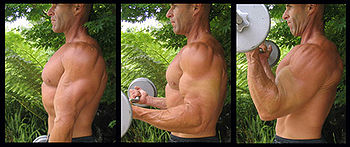
Biceps curl
Encyclopedia

Weight training
Weight training is a common type of strength training for developing the strength and size of skeletal muscles. It uses the weight force of gravity to oppose the force generated by muscle through concentric or eccentric contraction...
exercises that target the biceps brachii muscle
Biceps brachii muscle
In human anatomy, the biceps brachii, or simply biceps in common parlance, is, as the name implies, a two-headed muscle located on the upper arm. Both heads arise on the scapula and join to form a single muscle belly which is attached to the upper forearm...
in order to develop one or more of the following attributes:
- size
- definition
- strength
- endurance
- power
Biceps curls can be done using any of the following equipment:
- DumbbellDumbbellThe dumbbell, a type of free weight, is a piece of equipment used in weight training. It can be used individually or in pairs .-History:...
(s) - BarbellBarbellA barbell is a piece of exercise equipment used in weight training, weightlifting and powerlifting. Barbells range in length from to although bars above 7' in length are used primarily by powerlifters and aren't commonplace...
- E-Z bar (also known as a "Bent bar")
- Cable machineCable machineA cable machine is an item of equipment used in weight training or functional training. It consists of a rectangular, vertically-oriented steel frame about 3 metres wide and 2 metres high, with a weight stack at each end. The cables that connect the handles to the weight stacks run through...
- Biceps curling machine
- Nautilus cam equipment
- Preacher bench
- Adjustable bench
Overview
Although the exercises differ, a common factor of each is a 'curling' motion, where a weight—attached to an item of equipment listed above—is moved through an arc, primarily using the strength of the biceps. The biceps is contracted to lift the weight upward through the arc, to a point where further movement is not possible. It is important that the elbow remain next to the body during this motion as to keep stress on the biceps. The biceps is then extended, lowering the weight back through the arc, to the start position. This contraction and extension together constitute a single repetition. As with most weight training exercises, results from biceps exercises can be maximized with a proper understanding of flexionFlexion
In anatomy, flexion is a position that is made possible by the joint angle decreasing. The skeletal and muscular systems work together to move the joint into a "flexed" position. For example the elbow is flexed when the hand is brought closer to the shoulder...
.
Variations

The biceps curl is usually performed with the palms supinated
Supination
Supination is a position of either the forearm or foot; in the forearm when the palm faces anteriorly, or faces up . Supination in the foot occurs when a person appears "bow-legged" with their weight supported primarily on the anterior of their feet.The hand is supine in the anatomical position...
(facing upwards). Turning the palms inward transfers load from the biceps to the brachioradialis
Brachioradialis
Brachioradialis is a muscle of the forearm that acts to flex the forearm at the elbow. It is also capable of both pronation and supination, depending on the position of the forearm...
. Variations on this concept include the hammer curl, performed with the palm inward, neither pronated nor supinated, and the reverse curl, with the palms pronated (facing downwards).
Yet another variation, the Bench Press Curl, is unique in that it requires two people to function properly in. One, lying on the bench (similar to bench press) lowers the weight eccentricly to 1/2 the ROM as seen in bench press, and the other trainee, standing over the bar, actively curls the bar upwards (essentially a barbell curl) as the other actively presses up.
With an adjustable bench positioned at a 45 degree angle, one could perform incline bicep curls. Incline bicep curls are usually performed with dumbbells in each hand, and by sitting on the incline bench, holding the dumbbells close to the body with elbows tucked in, and performing a full curl.
Decline bicep curls are possible as well, and are usually performed with a preacher bench along with dumbbells, a straight bar, or a curved bar ("EZ bar"). With the elbows flat against the bench, and the chest pressed close to the preacher bench, one performs a traditional curl motion with the weights, focusing on stressing the biceps.
The incline and decline biceps exercises' effectiveness lie in gravity. Additional gravitational push is applied to the weight when performing the exercises at diagonal angles, increasing the stress on the biceps and therefore increasing the results from the exercises when performed correctly.
Another bicep curl variation is the "correct curl" where the palms are positioned on the barbell at the width they would land into once they are fully supinated. This variation heavily targets biceps with less involvement from your brachialis and brachioradialis muscles.

